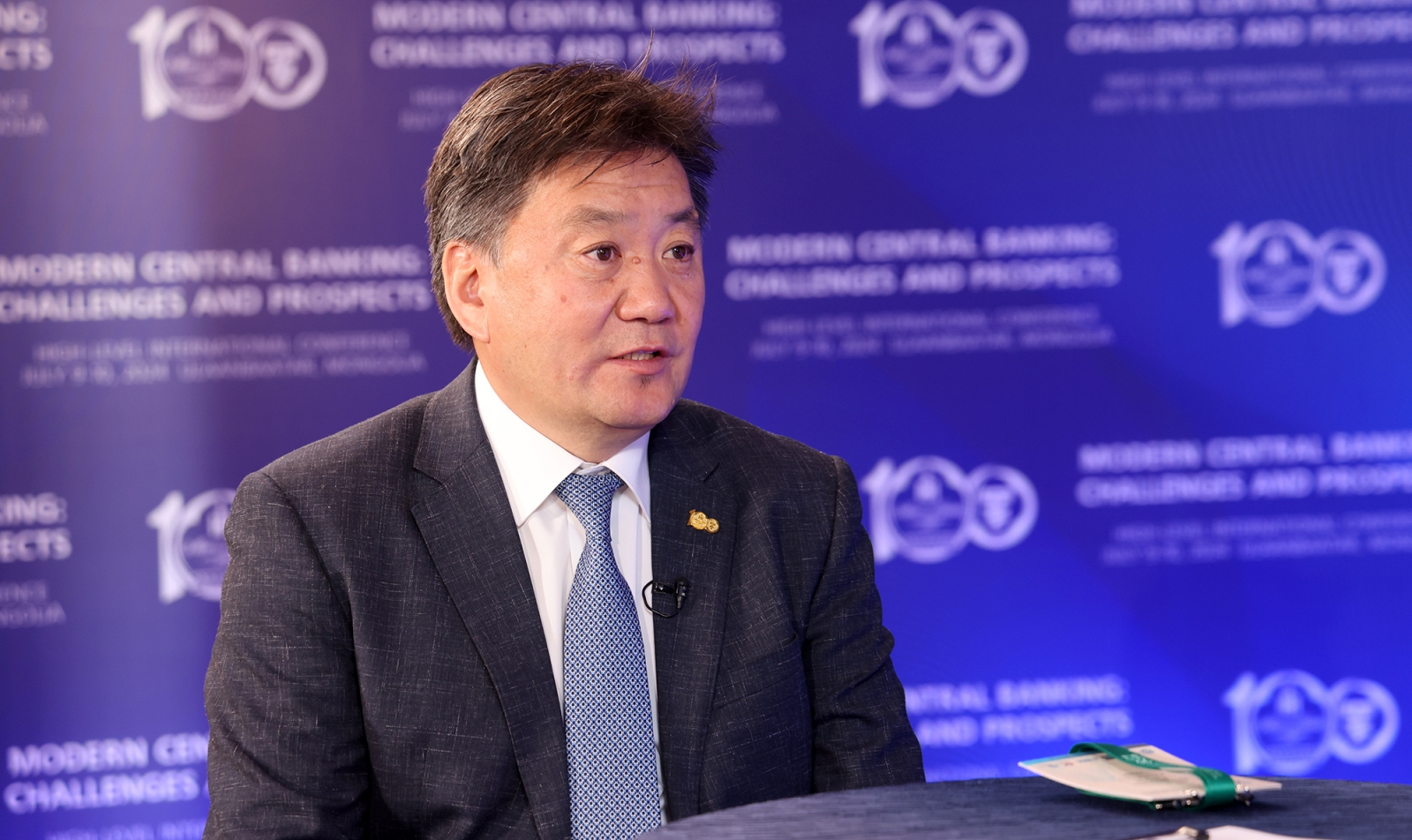Lkhagvasuren.B: The Bank of Mongolia is leading the way in establishing a sustainable financial system

During our interview, the Governor of the Bank of Mongolia, Lkhagvasuren.B emphasized the Central bank's role in establishing a sustainable financial system. We discussed the policies and initiatives to address climate change within the banking sector.
-Global trends are shifting towards implementing policies to combat climate change and promote sustainable green development. What is Mongolia's position on this matter?
-Its associated risks and challenges exceed the capacity of any single nation to resolve independently. Therefore, countries must collaboratively implement policies to mitigate these risks and minimize adverse impacts. This entails integrating new technologies and innovations across sectors and adapting business practices to address both risks and opportunities. For our country, the increasing frequency of adverse weather events and catastrophic phenomena and climate change is occuring at a rate twice as fast as the global average, which shows that the impacts of climate change are accelerating faster compared to other countries. Consequently, there is a need to reduce negative impacts and increase adaptability. Mongolia has committed to the international community to reduce greenhouse gas emissions by 22.7 percent compared to the base level by 2030 as part of the Paris Agreement. This necessitates banks and financial sectors transitioning towards a low-carbon economy by fostering increased private-sector investments and funding. Enhancing the green and sustainable business environment is critical, involving measures to boost competitiveness, improve policy coordination among public institutions, identify critical sectors for green and sustainable development, and establish clear sustainable development plans.
-Is our banking system prepared to increase green private-sector funding?
-Due to the current structure of the financial system, the banking sector will play an essential role in transitioning to green development and increasing private-sector financing. Banks must be well-informed leaders and must be connected to their users to effectively and seamlessly execute green and sustainable financing. The Mongolian Banking Association and banks have been actively engaging in this direction, establishing the Mongolian Sustainable Finance Association (MSFA), expanding foreign relations and cooperation, providing vocational training and advice, incorporating international standards and principles, and attracting green financing. To enhance the banking system's governance, strengthen the financial sector's stability, and increase investments and resource attractiveness, the "Banking Sector Reform Program" had been implemented between 2020 and 2023. An additional amendment to the Banking law of Mongolia now requires all commercial banks to operate as joint stock companies. As a result, five domestic systemically important banks (D-SIBs) in the banking system have transitioned to joint stock companies, organized an initial public offering for the first time, and raised 473.5 billion MNT. In doing so, the openness of the banking sector, public oversight, funding from foreign markets, and domestic loans increased. The Bank of Mongolia’s policies and activities aim to create a green and sustainable financial system, with the support of other government institutions and banks. Thus, there are reasonable grounds for forming a sustainable financial system and increasing green sources and loans.
-What is the role and involvement of the Bank of Mongolia in creating a sustainable financial system?
-The Bank of Mongolia, as the regulatory body of the banking sector, has taken the lead from the beginning in the direction of creating a "general line" of a sustainable financial system, creating a policy and regulatory environment, introducing common international standards and principles, and creating policy incentives. For example, the step-by-step planning and implementation of the necessary infrastructure to develop a system of green financing has been implemented in cooperation with relevant parties, as reflected in the main direction of the government's monetary policy between 2019 and 2024. In 2019, the Financial Stability Council (FSC) approved the "Green Taxonomy" starting from 2020, statistics on green loans in the banking sector have been released and reported to the public. In 2022, FSC developed and approved the "National Sustainable Financial Roadmap". In 2023, the FSC approved a more expanded version of the "Sustainable Development Goal Financing Taxonomy" while the Bank of Mongolia approved the bank's environment, social and governance (ESG) and climate risk assessment and management methods, respectively. In this way, it becomes possible to determine what constitutes green business and activities, and to measure the amount of credit issued accordingly. This ensures coordinated implementation of measures and timelines by parties, fostering sustainable financial system and step-by-step adoption of international methods and principles. With a clear and focused path to sustainable financing, it becomes feasible to advance faster, without risks, and extend further along that trajectory. Banks are actively working to attract funding from domestic and international markets to support green and sustainable businesses and projects. In that sense, it opens funding opportunities for green and sustainable entrepreneurs and project developers.

-Would you like to introduce the role of the banking industry and the Bank of Mongolia in implementing the "Sustainable Finance Roadmap" you mentioned?
-The "National Sustainable Finance Roadmap" set out the goal of "increasing the green loan portfolio of all banking sector lending to 10 percent by 2030." The Bank of Mongolia has been working to create the policy framework needed to meet this goal. Specifically, the banking sector is working towards introducing and tracking commonly accepted green and sustainable financing standards and principles, assessing the risks of climate change that could affect the financial system, and strengthening the ability to meet these risks. It has also provided fundamental conditions and environments for the development of sustainable and green finance, improved environmental, social and governance assessments and climate risk management, and provided support in terms of transparency. Major progress has been made on the key points reflected in the roadmap. For this year, the focus is on exploring the impact of policy tools, measuring the impact of sustainable and green funding, improving the measurement, reporting, and verification (MRV) system, and developing methodologies to assess the impact of climate change on the financial sector.
-Can the Bank of Mongolia implement measures to attain the goal of increasing the banking sector's green loan portfolio to 10 percent by 2030? What steps is the Bank of Mongolia undertaking towards achieving this target?
-While ambitious, we are confident in achieving this goal and are committed to pursuing it. As per the green taxonomy, green loans were categorized starting from the first quarter of 2020. At the beginning of reporting, the green loan portfolio stood at 428.1 billion MNT or 2.5 percent of total loans. However, by the first quarter of 2024, this portfolio had risen to 875.3 billion MNT, constituting 3.0 percent of total loans. The issuance of green loans in the first quarter of 2024 has surged by 2.3 times compared to the previous year. This escalation can be attributed to policy incentives introduced by the Bank of Mongolia, augmented bank resources from the foreign market, and active efforts towards expanding the domestic market. Expectations foresee a more rapid growth of green credit in the forthcoming years, driven by stringent reporting conditions and effectiveness verification associated with external green financing. Current projections suggest that the green loan portfolio will attain 6 percent of total loans by 2026 and 10 percent by 2030." Within its mandate, the Bank of Mongolia has played a role in promoting sustainable and green financing. The Bank of Mongolia provides policy support to reduce the cost and exchange rate risk of green financing sources drawn from foreign markets to create incentives for green loans. Also, the risk weight of green construction loans was reduced to 75 percent, a measure aimed at lowering bank’s cost of green loan operations and promoting green lending. In the future, we will conduct research and analysis to identify the subsectors in need of policy support and select the appropriate tools.
-What actions did the Bank of Mongolia implement to incorporate the impacts of climate change into its policies and operations?
-Climate change and environmental risks affect the goal of economic and financial stability. Consequently, central banks worldwide must evaluate the impact of these risks on the financial sector and the broader economy and take appropriate action. Since this is a new challenge, difficulties such as developing methods and localization from data have arisen. As for the Bank of Mongolia, we are working with technical assistance from international financial institutions to establish stress test methods to estimate the impact of these risks on the economy and financial sector and to develop and implement regulations necessary to strengthen our ability to overcome these risks. Our efforts will focus on fortifying green and sustainable financing systems, aligning policy and regulations with international standards, and adopting globally recognized principles. Moreover, in addition to identifying, assessing, and mitigating climate change-related risks in Mongolia's economic and financial sectors, we are exploring policies to identify the opportunities and benefits of transitioning from a brown economy to a green one. This initiative is expected to become a medium-term priority in monetary and financial policy, guiding the direction of banking and financial sector policies.
-How is the banking sector involved in supporting the "Billion Tree" national movement?
-Banks and financial institutions are collaborating closely with the national "Billion Trees" movement in Mongolia. The "Mongolian Billion Tree Fund" was established within this collaboration to develop a sustainable financing framework for nature conservation efforts. Banks and financial institutions initiated the establishment of this fund, which came into existence with the backing of policy support from the Bank of Mongolia. The "Mongolian Billion Tree Fund" is nearing its one-year milestone since inception, aligning with global standards prioritizing governance, transparency, and autonomy. Currently, One hundred thousand trees have been successfully planted through micro-project financing, with a completion rate of 60 percent. Additionally, plans are underway to plant over five hundred thousand trees this year as part of a large-scale afforestation endeavor. Beyond the sheer quantity of trees, this initiative yields numerous positive outcomes, such as establishing child-friendly surroundings, expanding green areas, providing ecological education, and generating economic benefits. As the fund continues to operate smoothly and expand in the future, there's potential to enhance support for nature conservation on a broader level. Collaborating institutions, led by the Bank of Mongolia, diligently facilitate the fund's donation and financing of the initiatives. Rather than one-time funding and measures, the principle of paying more attention to the direction of positive side effects, such as the sustainability and feedback of tree planting and maintenance activities, and the beautification of green structures in urban areas, schools, and kindergartens, is being followed. -Thank you for the interview. I wish you all the best in your future endeavors.
